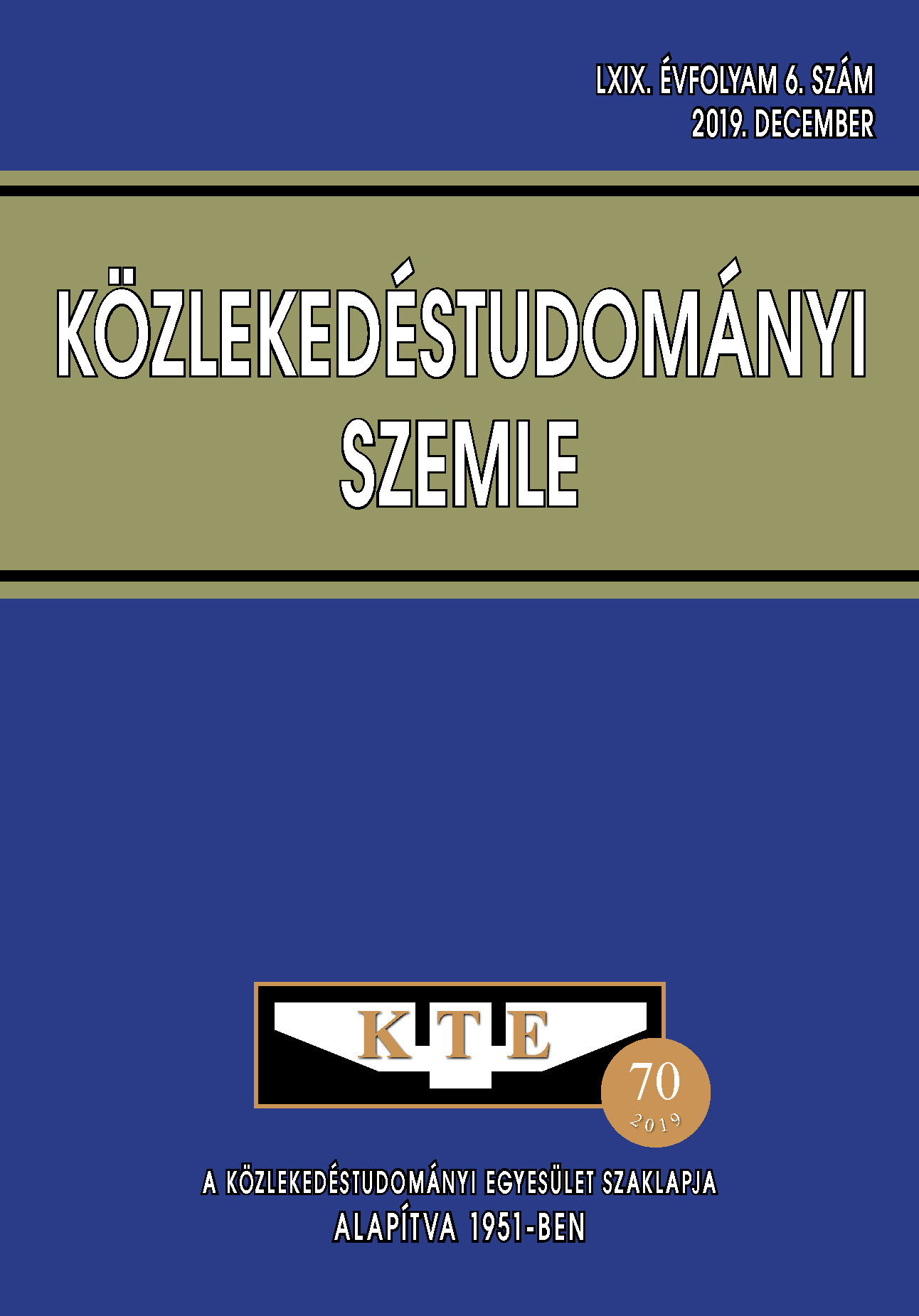The derivation and application possibilities of a stochastic shock wave model
Abstract
On busy city routes, traffic light cycles fundamentally determine the flow of traffic. An accurate knowledge of queue lengths forming at intersections with traffic lights is essential when operating intelligent intervention systems. Starting from the macroscopic fundamental diagram, this article introduces a shock wave model that incorporates the stochastic behaviour of vehicle traffic to derive the shock wave and queue length distribution functions. The model is validated using microscopic traffic simulation software and Monte Carlo simulation. The main conclusion is that the stochastic shock wave model can be effectively applied for modelling urban traffic.
References
P. B. Hunt, D. I. Robertson, R.D. Bretherton, and R. I. Winton,“SCOOT - A traffic responsive method of coordinating signals,” TRL Lab., Wokingham, U.K., Tech. Rep. 1014, 1981
V. Mauro and C. D. Taranto, “UTOPIA,” in Control, Computers, Communications in Transportation Research, J. P. Perrin, Ed. Oxford,U.K.: Pergamon, 1990, pp. 245–252. DOI: http://doi.org/ddn9
A. A. Zaidi, B. Kulcsár, H. Wymeersch, Back-pressure traffic signal control with fixed and adaptive urban vehicular networks, IEEE Transactions on Intelligent Transportation Systems 17 (8) (2016) 2134-2143. DOI: http://doi.org/f3scmz
H. Yang, H. Rakha, M. V. Ala, Eco-cooperative adaptive cruise control at signalized intersections considering queue effects, IEEE Transactions on Intelligent Transportation Systems 18 (6) (2017) 1575-1585. DOI: http://doi.org/ddpb
A. Sharma, D. Bullock, J. Bonneson, Input-output and hybrid techniques for real-time prediction of delay and maximum queue length at signalized intersections, Transportation Research Record: Journal of the transportation Research Board 8 (2035) (2007) 69{80. DOI: http://doi.org/fw429q
M. Fathy, M. Siyal, A window-based image processing technique for quantitative and qualitative analysis of road traffic parameters, IEEE Transactions on Vehicular Technology 47 (4) (1998) 1342{1349. DOI: http://doi.org/czdn5t
G. Comert, M. Cetin, Queue length estimation from probe vehicle location and the impacts of sample size, European Journal of Operational Research 197 (1) (2009) 196-202. DOI: http://doi.org/dj5z45
H. X. Liu, X. Wu, W. Ma, H. Hu, Real-time queue length estimation for congested signalized intersections, Transportation Research part C: Emerging Technologies 17 (4) (2009) 412-427. DOI: http://doi.org/dprtn9
D. Heidemann, Queue length and delay distributions at traffic signals, Transportation Research Part B: Methodological 28 (5) (1994) 377-389. DOI: http://doi.org/d6rt6h
G. K. Mung, A. C. Poon, W. H. Lam, Distributions of queue lengths at fixed time traffic signals, Transportation Research Part B: Methodological 30 (6) (1996) 421-439. DOI: http://doi.org/bfdhmz
F. Zheng, S. E. Jabari, H. X. Liu, D. Lin, Traffic state estimation using stochastic Lagrangian dynamics, Transportation Research Part B: Methodological 115 (2018) 143-165. DOI: http://doi.org/gd7zrc
X. Wu, H. X. Liu, A shockwave profile model for traffic flow on congested urban arterials, Transportation Research Part B: Methodological 45 (10) (2011) 1768-1786. DOI: http://doi.org/dpjqxq
Luspay T., Tettamanti T., Varga I.: Forgalomirányítás, Közúti járműforgalom modellezése és irányítása, ISBN 978-963-279-665-9, Typotex Kiadó, Budapest, 2011
K Aboudolas, M. Papageorgiou, E. Kosmatopoulos, Store-and-Forward based methods for the signal control problem in large-scale congested urban road networks, Transportation Research Part C: Emerging Technologies 17 (2) (2009) 163-174. DOI: http://doi.org/dv7df6
L. Arnold, Random dynamical systems, Springer Science and Business Media, 2013.
D. Heidemann, Queue length and delay distributions at traffic signals, Transportation Research Part B: Methodological 28 (5) (1994) 377-389. DOI: http://doi.org/d6rt6h
S. Karlin, A first course in stochastic processes, 2nd Edition, Academic Press, 1957, DOI: http://doi.org/ddpd
Leyn, U. and Vortisch, P, Calibrating VISSIM for the German Highway Capacity Manual. Karlsruhe Institute of Technology: Institute for Transport Studies, (2014) 1-11. DOI: http://doi.org/ddpf
Articles published electronically are open access (OJS), freely available online and can be downloaded. Authors of articles are not charged any publication or publishing costs (APC). Users have the right to read, download, copy, print, and search the articles, or share the full text with a link.
Authors must declare that their submission has not been previously published in another journal, that financial support has been acknowledged, and that the list of references is complete and accurate, including specification of URLs and DOIs (if available). When submitting a draft article, each author approves the submitted version. Authors guarantee that the article is their original work. Authors are required to participate in the peer review process, follow the advice of reviewers, meet the prescribed deadlines, and, if any, withdraw the submission or correct errors.
All submitted articles are subject to peer review, where the editors request an independent evaluation from at least one expert, ensuring that the reviewer(s) have no conflicts of interest with the authors. The final decision is made by the Editor-in-Chief, who takes into account the evaluations and the suggestions of the editors. The editors and reviewers treat the submission confidentially.
The publisher and editors are committed to maintaining high ethical standards and to preventing publications that involve research misconduct. They follow the COPE guidelines on such ethical issues.
The authors retain copyright and grant the journal the right of first publication under the Creative Commons License (https://creativecommons.org/licenses/by-nc-nd/4.0), which allows others to share the work, while acknowledging the authorship of the work and the first publication in the journal.
The journal archives all published articles, and the journal's owner, the Hungarian Society of Transportation Sciences, will continue to operate the database even if the journal ceases to be published.















